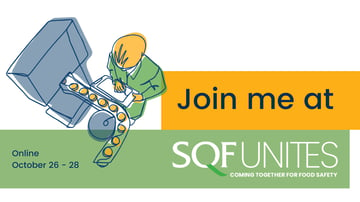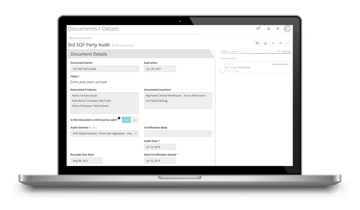There’s no denying that, in the world of food safety and product quality assurance, auditing is a staple. At the end of the day, a robust auditing program can make or break a brand and its affiliated reputation. This is because, by nature, audits empower organizations to institute preventive measures, continually uphold product quality and safety, and, when necessary, address issues swiftly and definitively – consistently maintaining brand promise and therefore, consumer trust.
A mature auditing practice coincidentally takes a variety of forms, both in format and execution. Speaking to the former, it’s common for food companies to host a blend of first, second and third-party audits in their arsenal, and FoodLogiQ customers are no exception. In the spirit of continuing to evolve and progress the FoodLogiQ Connect platform, we are excited to announce the expansion of FoodLogiQ’s auditing functionality to include internal audits.
Designing, Configuring and Designating Internal Audits
FoodLogiQ’s Fall ‘20 Release included the addition of internal audits to FoodLogiQ’s Manage + Monitor solution. Utilizing this new functionality, organizations across the food industry can execute internal audits to guarantee that locations continually meet brand standards and ongoing compliance, as well as prepare for external, third party audits. In practice, this might look like a consumer packaged goods company executing a daily HACCP checklist, a retail organization preparing for an SQF audit, or a restaurant performing daily hygiene checks.
Within FoodLogiQ Connect, users with administrative rights have complete control over the design, configuration, scheduling and execution of internal audits across their organization. Utilizing the audits template builder within Manage + Monitor, admins can create and customize internal auditing templates, adding in supplementary notes, commentary and attachments for context, as well. The latter might even include custom scoring and automatically generated warnings based on auditee response.
It’s important to note that these digital auditing templates, as well as FoodLogiQ’s internal auditing functionality as a whole, are designed for mobile rendering and thus, are available on FoodLogiQ’s mobile application. This makes it incredibly easy to execute first party audits at any location, regardless of internet connection. Thus, if a store or facility is based in a remote location, utilizes an underground storage system or lacks consistent connectivity for other reasons, the internal auditing process can still be completed with ease. As with supplier self-assessments and supplier audits, internal audit results will automatically upload once internet connection is restored.
In addition to template configuration control, another novel ability users have with FoodLogiQ Audits and Assessments is the ability to utilize template-level permissions. That is, to specify which individuals have access to make edits or changes to audit templates. For example, a brand may wish to provide a specific department with the ability to view internal audit results within FoodLogiQ Connect, but limit that department from being able to edit the internal audit format itself. With the introduction of template-level permissions, food companies can stipulate which users within their organization have this capability. In addition, they can determine who is notified when the completed audit is submitted, designating notification recipients according to internal role.
Scheduling Recurring Audits for Ongoing Compliance
To ensure continual compliance and improve safety standards, food brands can schedule recurring supplier audits, supplier self-assessments and internal audits at their desired frequency in Connect. In this way, the platform eliminates the manual process of repeatedly preparing, executing and reporting on audits that occur at specific intervals, reducing staff’s time investment significantly.
As part of the Fall ‘20 Release, certain aspects of the audits scheduler have been enhanced and redesigned to clarify and simplify the process of conducting regular audits. For instance, within the audit scheduler, fields will now change dynamically based on the type of task at hand (i.e. supplier self-assessment, supplier audit or internal audit). In addition, admins have the option of choosing from template types according to auditing format, such as internal audit or supplier audit, and can specify which locations pertain to an internal audit. As mentioned above, users with administrative rights may also select who should be notified for review once an audit is complete, and can also schedule the audit to occur at a variety of predetermined frequencies.
Assigning Corrective Actions and Custom Scoring
It’s vital for food companies to identify and communicate problems quickly during an audit or assessment, as well as maintain a securely documented history of actions taken. As with supplier audits and self-assessments, FoodLogiQ’s internal auditing functionality features the ability to craft custom scoring and assign corrective actions based on auditee response. Speaking to the former, food companies can designate custom scores for specific questions included in an internal audit, weighing certain categories and questions accordingly. When an audit is completed, users can review the cumulative score to grade location performance, identify locations requiring attention and take action. Additionally, organizations can utilize reporting within FoodLogiQ Connect to determine trends across locations, facilities or stores over time.
For those responses requiring attention and immediate action, brands can quickly trigger Corrective and Preventive Actions (CAPAs) to swiftly address existing issues and prevent subsequent ones. In Connect, users can create corrective actions in response to particular answers as they arise, as well as notify appropriate individuals about the required CAPA(s). This data can also be exported for further analysis and future reference, and will not only reflect associated CAPAs, but will also include any affiliated point values. The latter is key for identifying and instituting process improvements, as well as documenting a secure, detailed history of events.
Getting Started with Internal Audits
FoodLogiQ’s addition of internal audits to our existing Audits and Assessments functionality is a development we’re particularly excited about. From replacing manual processes and halving time investments, to facilitating better cross-departmental collaboration and communication, identifying and reviewing CAPAs, and improving business processes over time, the benefits are clear. Collectively, these aspects form a key part of a mature auditing strategy designed to prevent and respond to issues, as well as ultimately uphold brand promise and maintain consumer trust.
This functionality is one that enterprise-level brands can begin to deploy, review and report on today. To learn more about FoodLogiQ’s first, second and third-party auditing capabilities, visit our Knowledge Base or contact us for additional information.
Tag(s):
Trustwell News
Other posts you might be interested in
View All Posts
Supplier Compliance
9 min read
| October 21, 2021
Embracing the Value of FoodLogiQ’s Global Supplier Network
Read More
Food Safety
6 min read
| October 29, 2021
FoodLogiQ's Key Takeaways from SQF Unites 2021
Read More
Trustwell News
9 min read
| May 14, 2021

